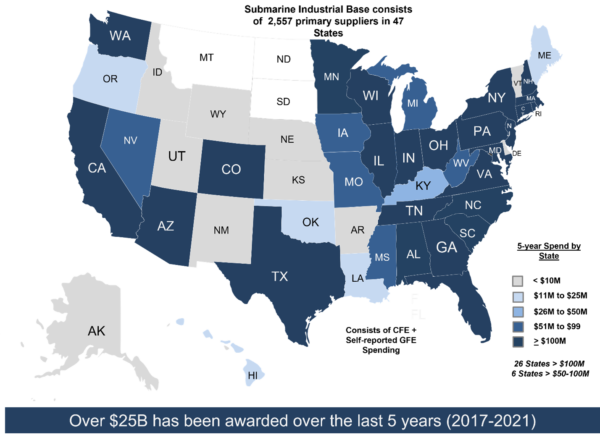For initial inquiries, please refer to the below information. For further detail, please reach out to sibc@submarinesuppliers.org.
MISSION STATEMENT
The Submarine Industrial Base Council’s mission is to educate policymakers and the public on the need to preserve the strength of the U.S. submarine force and promote the value of the submarine industrial base as a vital part of our national security structure.
MEDIA CONTACT
OUR LEADERSHIP
CO-CHAIRS
Pat Herschkowitz,Steve Dobos, Butler Weldments
Keith MacDowell, Prime Technology
REGIONAL LEADERS
New England:
Henry Scott, Corrosion Materials
Dawn Massa Stancavish, Massa Products Corporation
Connecticut:
Julie Brink, LM Gill Welding & Manufacturing
Pennsylvania:
Andrew Clancy, Johnson Controls Navy Systems
Paul Trenholm, Derbyshire Machine & Tool Co.
New York, New Jersey & Mid-Atlantic:
Josh Guedesse Curtiss-Wright
Virginia:
Lauren Yancey, Hi-Test Laboratories
Central/Mid-West:
Kevin Cantrell, American Tank & Fabricating Co.
Jared Veteto, Cogitic Corporation
South:
Tony Deering, Pegasus Steel LLC
West:
Paul Gold, Sargent Aerospace and Defense
Andrew Baldwin. VACCO Industries
OUR ROOTS: THE SUBMARINE INDUSTRIAL BASE COUNCIL
Established in 1992, the Submarine Industrial Base Council seeks to educate policymakers and the public about the need to preserve the strength of the U.S. submarine force and promote the value of the submarine industrial base as a vital part of our national security.
SIBC membership is open to thousands of U.S. companies that provide critical materials to U.S. submarine programs under development or in production. Member businesses range from the smallest specialty shops to manufacturers of main propulsion equipment.

The SIBC encourages its membership to engage in dialogue with decision and policy makers and can provide materials at the local, state and national level. The SIBC’s cornerstone event is Submarine Supplier Days, an annual Washington, DC, fly-in of more than 400 suppliers and executives for briefings and congressional engagement.
All SIBC activities are voluntary. There are no membership fees and travel expenses are borne by each individual company.
FACT SHEET
- U.S. submarine programs and the submarine industrial base are critical to our national defense, economic security and ensuring our worldwide undersea dominance.
- The submarine industrial base supports tens of thousands of high-skill, high-wage jobs across the country, contributing $25.4 billion to local economies over the past 5 years.
- There are three major classifications of modern U.S. submarines: nuclear powered attack submarine (SSN), nuclear powered guided missile submarine (SSGN), and nuclear powered ballistic missile submarine (SSBN).
- SSN and SSGN submarines give the Navy unparalleled stealth and strike capability to support Special Operations Forces and carry out intelligence, surveillance and reconnaissance missions.
- The Los Angeles Class, Seawolf Class, and Virginia Class submarines represent the SSN force currently deployed by the Navy, utilizing the most advanced undersea systems that American world-class science, engineering, technology and manufacturing can provide.
- Virginia Class Attack Submarines with the Virginia Payload Module (VPM) produced at a rate of at least two per year are essential to maintain Navy undersea dominance and strike capability. The U.S. currently has 50 fast attack submarines, including 21 Virginia Class The most recent Future Naval Force Study calls for at least 72 SSNs by 2045.
- The current S. SSBN force consists of 14 Ohio Class submarines. Ohio Class SSBNs are specifically designed for extended deterrent patrols.
- Trident II D5 missiles with improved accuracy and range, efficient crew rotations and low maintenance demands maximize the SSBN’s strategic availability as well as reduce the number of submarines required to meet strategic requirements and readiness.
- SSBNs carry 70% of the S. operational nuclear deterrent arsenal, using only 1% of the overall Defense Department budget.
- SSBNs are the most survivable component of the United States’ nuclear triad— comprised of submarine-launched ballistic missiles, land-based ICBMs and heavy bombers. Deep in the ocean, with virtually unlimited endurance, these submarines are capable of reaching any target at the direction of the President.
- The Columbia SSBN program must deliver a minimum of 12 submarines to replace the current Ohio Class fleet. With a planned 42-year service life, the Columbia Class will deter strategic threats into the late 21st century.
- Construction of the first Columbia Class SSBN construction began in October

 Submarine Industrial Base Council
Submarine Industrial Base Council